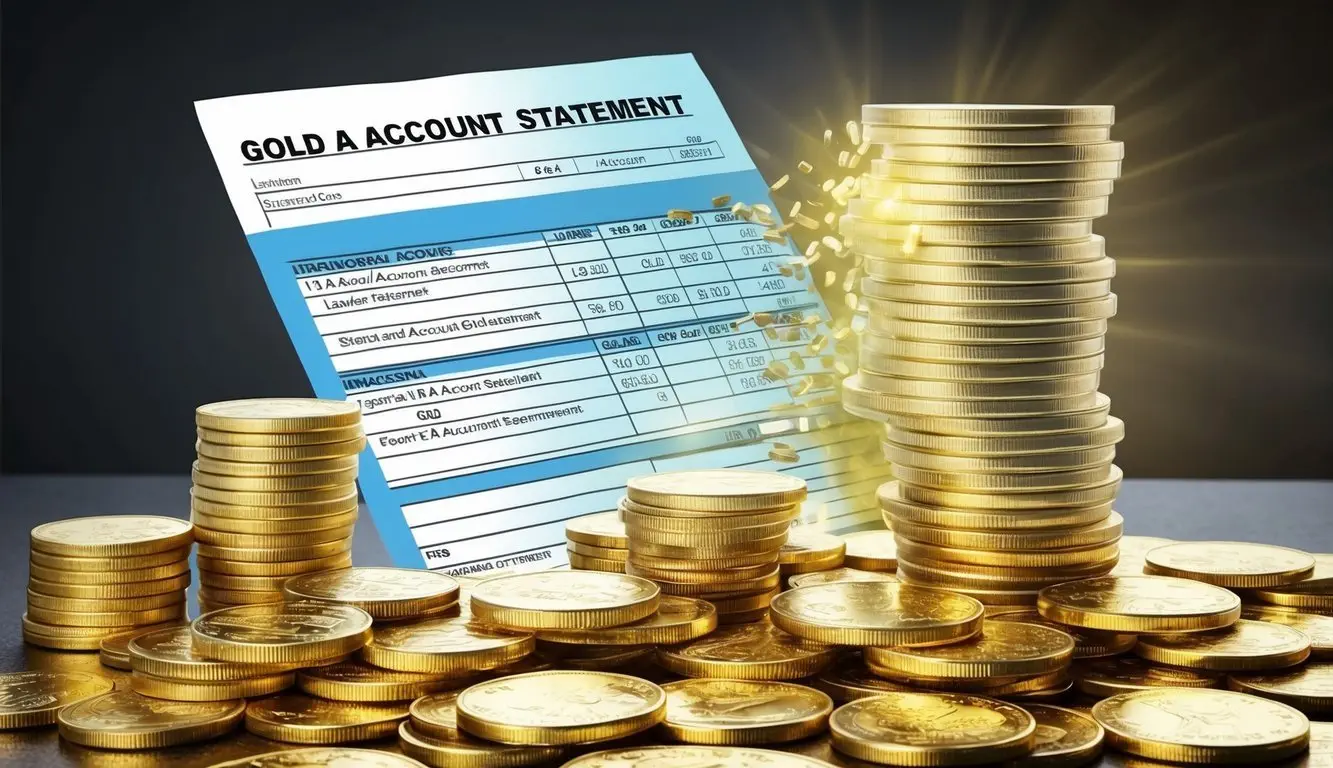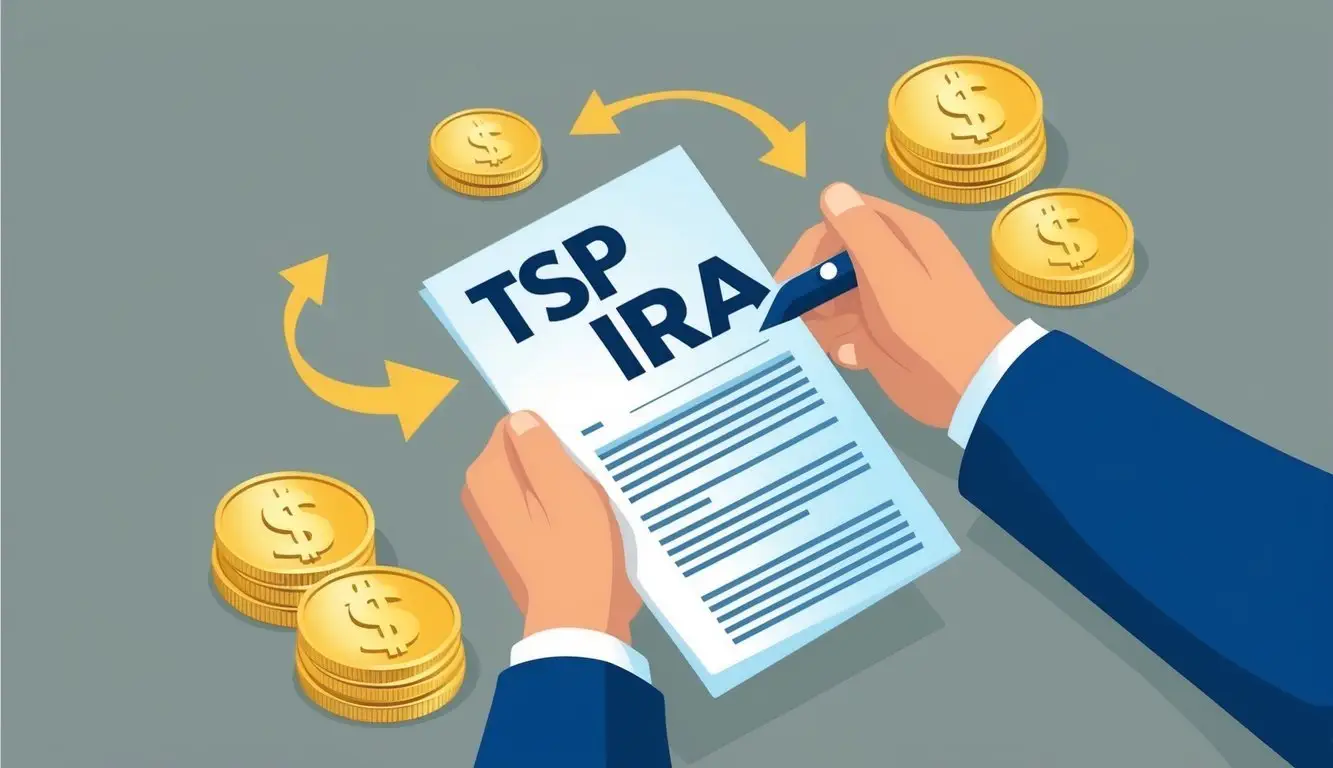Are you looking to diversify your retirement savings? Moving funds from your Thrift Savings Plan (TSP) to a Gold IRA might be an option worth exploring. This strategy allows federal employees to convert part of their retirement savings into physical gold and other precious metals.

Converting your TSP to Gold IRA can provide protection against inflation and market volatility that traditional retirement accounts may not offer. The process involves rolling over funds from your TSP to a self-directed IRA that allows investment in gold, silver, platinum, and palladium.
Many retirement planners suggest diversification as a key strategy for long-term financial security. While the TSP offers limited investment choices, a Gold IRA opens up alternative options that don’t move in lockstep with the stock market, potentially creating a more balanced retirement portfolio.
Understanding the Thrift Savings Plan (TSP)

The Thrift Savings Plan serves as the government’s version of a 401(k) retirement savings plan for federal employees and military members. It offers tax advantages while providing various investment options to help participants build retirement wealth.
Basics of TSP
The TSP is a defined contribution plan created by Congress in 1986 as part of the Federal Employees’ Retirement System (FERS). It allows government workers and military personnel to save for retirement through automatic payroll deductions.
TSP accounts offer tax advantages similar to traditional and Roth retirement accounts. With traditional TSP contributions, money goes in pre-tax, reducing current taxable income. Taxes are paid when funds are withdrawn during retirement.
Roth TSP contributions are made with after-tax dollars. This means contributions don’t reduce current taxes, but qualified withdrawals in retirement are completely tax-free.
Account management is handled through the TSP website or ThriftLine phone service, where participants can check balances, adjust contributions, and manage investments.
TSP Investment Options
The TSP offers five individual funds that participants can invest in:
- G Fund: Government securities with protection against principal loss
- F Fund: Fixed income index tracking U.S. government and corporate bonds
- C Fund: Tracks the S&P 500 Index of large U.S. companies
- S Fund: Covers smaller U.S. companies not in the S&P 500
- I Fund: Invests in international stocks from developed markets
The TSP also offers Lifecycle Funds (L Funds) that automatically adjust the investment mix based on your target retirement date. These funds shift from aggressive to conservative as you approach retirement.
Each fund has different risk levels and potential returns. The G Fund is the most conservative with the lowest returns, while the C, S, and I Funds have higher risk but potentially higher long-term growth.
Eligibility and Contributions
All federal employees covered by FERS and members of the uniformed services are eligible to participate in the TSP. Most FERS employees are automatically enrolled at a 5% contribution rate.
The annual contribution limit for 2025 is $23,000, with an additional $7,500 catch-up contribution allowed for those 50 and older. These limits may change yearly based on IRS adjustments.
FERS employees receive automatic agency contributions of 1% of their salary. They can also earn matching contributions up to 4% more when they contribute their own money.
Military members under the Blended Retirement System (BRS) receive similar matching benefits. After two years of service, all contributions are fully vested, meaning the money belongs to the participant even if they leave federal service.
Withdrawing from TSP
TSP participants can access their funds through various withdrawal options. In-service withdrawals are available for those still employed, including age-based withdrawals (after 59½) and hardship withdrawals for financial emergencies.
After leaving federal service, participants can take partial withdrawals, full withdrawals, or set up monthly payments. They can also transfer funds to another qualified retirement account like an IRA.
Required Minimum Distributions (RMDs) begin at age 73, requiring participants to withdraw a minimum amount annually based on life expectancy.
Early withdrawals before age 59½ typically incur a 10% tax penalty unless exceptions apply. The TSP offers a loan program allowing participants to borrow from their accounts and repay with interest.
What Is a Gold IRA?

A Gold IRA is a specialized individual retirement account that allows investors to hold physical precious metals as qualified retirement investments instead of traditional paper assets like stocks or mutual funds.
The Role of a Custodian
A Gold IRA custodian acts as the financial institution responsible for managing and safeguarding your precious metals investments. Unlike standard IRAs, Gold IRAs require specialized custodians approved by the IRS to handle physical assets.
These custodians coordinate the purchase, storage, and sale of your precious metals. They ensure your gold and other metals are stored in IRS-approved depositories with proper insurance and security measures.
Custodians also handle all IRS reporting requirements and provide regular statements showing the value of your metals. Fees for custodian services typically include annual administration costs and storage fees based on the value of metals held.
Types of Precious Metals Allowed
The IRS has specific requirements for metals that qualify for inclusion in a Gold IRA. Not all precious metal products meet these standards.
Approved metals include:
- Gold (minimum purity of 99.5%)
- Silver (minimum purity of 99.9%)
- Platinum (minimum purity of 99.95%)
- Palladium (minimum purity of 99.95%)
Common eligible products include American Eagle coins, Canadian Maple Leaf coins, and certain bars produced by approved refiners. Collectible coins and numismatic items generally don’t qualify for IRAs.
The metals must be stored in an approved depository and cannot be held personally by the investor. Proper documentation confirming purity and authenticity is required for all metals in the account.
Physical vs Paper Gold
Investors in Gold IRAs can choose between physical gold ownership and paper gold investments, each with distinct characteristics.
Physical gold includes actual bullion coins and bars stored in secure depositories. These tangible assets offer direct ownership of the metal itself. They provide protection against financial system failures but come with storage costs and insurance fees.
Paper gold refers to investments that track gold prices without physical ownership. Options include:
- Gold ETFs (Exchange-Traded Funds)
- Gold mining stocks
- Gold mutual funds
- Gold certificates
Paper gold typically offers greater liquidity and lower fees. It’s easier to buy and sell quickly compared to physical metals. However, these investments may carry counterparty risk since they represent a claim on gold rather than actual possession.
The Process of Rolling Over TSP to Gold IRA

Converting your Thrift Savings Plan to a Gold IRA involves several steps that must be completed correctly to avoid tax penalties. This process requires understanding specific rollover rules, tax implications, and selecting a reputable Gold IRA company.
Rollover Guidelines
The TSP to Gold IRA rollover must follow strict IRS regulations. There are two main methods to complete this transaction: direct rollover and indirect rollover.
A direct rollover (also called a trustee-to-trustee transfer) is the safest option. Your TSP funds move directly to your new Gold IRA custodian without you handling the money. This method avoids potential tax withholding and penalties.
With an indirect rollover, you receive the funds personally and must deposit them into the Gold IRA within 60 days. Be cautious with this approach – the TSP administrator will withhold 20% for taxes.
You can only perform one IRA rollover per 12-month period across all your IRA accounts. This rule doesn’t apply to direct transfers, making them more flexible.
Taxes and Penalties to Consider
Rolling over your TSP to a Gold IRA has important tax implications. When done correctly, a direct rollover is tax-free and avoids early withdrawal penalties.
If you choose an indirect rollover and miss the 60-day window, the entire amount becomes a taxable distribution. Additionally, if you’re under 59½, you’ll face a 10% early withdrawal penalty.
Remember these key points:
- The 20% tax withholding on indirect rollovers requires you to make up that amount from personal funds
- Required Minimum Distributions (RMDs) cannot be rolled over
- Roth TSP and traditional TSP have different tax treatment
Maintaining the same tax status in your new Gold IRA (traditional to traditional, Roth to Roth) helps avoid unexpected tax consequences.
Choosing the Right Gold IRA Company
Selecting a reputable Gold IRA company is crucial for a successful rollover. Look for companies with:
- Strong reputation – Check Better Business Bureau ratings and customer reviews
- Transparent fee structure – Understand all setup, storage, and management fees
- IRS-approved storage options – Gold must be stored in approved depositories
The best Gold IRA companies offer dedicated account representatives to guide you through the rollover process. They should help with paperwork and ensure compliance with IRS regulations.
Compare several companies before deciding. Some offer promotional deals like waived fees for new accounts with minimum deposits. Ask about the types of precious metals they offer and their buyback policies.
Retirement Planning with Gold IRAs

Gold IRAs offer a unique approach to securing your financial future by incorporating precious metals into your retirement strategy. They provide both protection against market volatility and potential for long-term growth.
Benefits of Diversifying Your Portfolio
Diversification is a cornerstone of sound retirement planning. Adding gold to your retirement portfolio helps spread risk across different asset classes.
When stock markets fluctuate, gold often moves in the opposite direction. This negative correlation can help stabilize your overall retirement savings during economic downturns.
Gold serves as a hedge against inflation, preserving purchasing power when the dollar weakens. This protection is particularly valuable for long-term retirement planning.
Many financial advisors recommend allocating 5-15% of retirement assets to precious metals. This balanced approach maintains growth potential while adding a protective element to your investment strategy.
Gold’s tangible nature provides peace of mind that paper-based investments cannot match. Unlike stocks or bonds, physical gold cannot go bankrupt or default.
Comparing Gold IRA to Other Retirement Accounts
Gold IRAs follow similar tax structures as Traditional IRAs but hold physical precious metals instead of paper assets. Contributions may be tax-deductible, with taxes paid upon withdrawal during retirement.
Unlike 401(k) plans or 403(b) accounts that typically offer limited investment options, Gold IRAs provide direct ownership of physical precious metals. This creates true diversification outside the financial system.
Traditional retirement accounts like defined contribution plans primarily hold stocks, bonds, and mutual funds. These assets can all decline simultaneously during market crashes.
Roth Gold IRAs offer tax-free growth and withdrawals, provided you meet qualified distribution requirements. This structure can be particularly advantageous if gold prices appreciate significantly.
Converting a portion of an existing retirement account to a Gold IRA requires working with a specialized custodian. The process involves a trustee-to-trustee transfer to avoid tax penalties.
Self-directed IRAs allow the greatest flexibility for including gold alongside other alternative investments. This approach enables a truly customized retirement strategy tailored to individual risk tolerance.
Frequently Asked Questions Regarding TSP to Gold IRA

Many TSP account holders have questions about converting their retirement savings to gold investments. These questions typically involve eligibility requirements, post-rollover management, and important risk considerations.
Can All Types of TSP Accounts Be Rolled Over?
Not all TSP accounts qualify for gold IRA rollovers. Traditional TSP accounts can be rolled over to Gold IRAs through a direct or indirect transfer process.
Roth TSP accounts can also be transferred, but only to Roth Gold IRAs to maintain their tax-advantaged status. This preserves the tax-free withdrawal benefits during retirement.
Military and federal employees with active TSP accounts generally cannot roll over funds while still employed by the government. However, those who have separated from service face fewer restrictions.
FERS and CSRS participants should note that different rules may apply based on their specific retirement system. It’s advisable to consult with a financial advisor familiar with government retirement plans before proceeding.
How Do Gold IRA Investments Work Post-Rollover?
After completing a TSP to Gold IRA rollover, your retirement funds are managed by a custodian specializing in precious metals. This custodian handles all administrative tasks and ensures IRS compliance.
Your investments must be in IRS-approved precious metals. These include gold coins or bars with minimum fineness requirements (typically 99.5% pure for gold), as well as silver, platinum, and palladium in certain forms.
Physical storage is mandatory. The IRS requires that gold in IRAs be stored in an approved depository facility. Home storage is not permitted under government regulations.
You’ll pay annual fees for storage and custodial services. These typically range from $100-$300 per year, depending on your provider and the value of metals stored.
What Are the Risks and Considerations?
Market volatility represents a significant risk with Gold IRAs. Precious metals prices can fluctuate substantially, sometimes experiencing dramatic short-term swings.
Gold IRAs lack the diversification of traditional retirement portfolios. While gold can serve as a hedge against inflation, concentrating too much retirement wealth in one asset class increases risk.
Liquidity concerns should be considered. Converting physical gold back to cash can take time and may involve fees or unfavorable pricing during market downturns.
The cost structure differs from traditional investments. Gold IRAs typically involve higher fees, including storage costs, insurance, and custodial fees that can erode returns over time.
Tax implications vary based on account type. Early withdrawals face the same penalties as traditional retirement accounts plus potential complications with physical asset distribution.
Lifecycle Planning and Long-Term Security

Planning for retirement requires careful consideration of how your assets will perform over time. Converting a TSP to a Gold IRA can play a significant role in creating financial stability throughout your retirement years.
Impact of Inflation on Retirement Savings
Inflation erodes purchasing power over time, making it a serious threat to retirement savings. A dollar today will not buy the same amount of goods in 20 years. Traditional retirement accounts often fail to keep pace with inflation.
Gold IRAs offer protection against this erosion. Historically, gold prices have moved inversely to the dollar’s value. When inflation rises, the dollar weakens, but gold typically increases in value.
For example, during the high inflation period of the 1970s, gold prices rose from $35 per ounce to over $800. This represents a significant outperformance compared to traditional savings methods.
Retirees who allocated 10-15% of their portfolio to precious metals have often seen better preservation of wealth during inflationary periods. This protection becomes increasingly important as retirement lengthens.
Strategies for Maintaining Wealth in Retirement
Diversification remains the cornerstone of retirement wealth preservation. A Gold IRA should complement other retirement vehicles rather than replace them entirely.
Financial advisors typically recommend a three-bucket approach:
- Short-term needs (1-3 years): Cash and liquid assets
- Medium-term needs (4-10 years): Bonds and dividend stocks
- Long-term growth: Gold, other precious metals, and growth investments
Regular portfolio rebalancing is essential. As retirement progresses, investors should adjust their gold allocation based on economic conditions and personal needs.
Tax considerations also impact wealth preservation. Gold IRAs offer the same tax advantages as traditional IRAs while providing inflation protection. Distributions must begin at age 72, so planning withdrawal strategies in advance helps maximize tax efficiency.
Tips for Managing Your Gold IRA

Managing a Gold IRA effectively requires understanding fee structures, monitoring your investments, and staying compliant with IRS regulations. These key aspects will help maximize your investment’s potential while avoiding costly mistakes.
Understanding Fees and Expenses
Gold IRAs typically involve several fees that can impact your overall returns. Most custodians charge an annual maintenance fee ranging from $75 to $300. This covers account administration and reporting to the IRS.
Storage fees are unavoidable, as physical gold must be held in an IRS-approved depository. These typically run between $100-$300 annually, depending on the value of your holdings.
Transaction fees apply when buying or selling precious metals within your Self-Directed IRA. They generally range from $40-$150 per transaction.
Some custodians also charge setup fees ($50-$200) when establishing a new Gold IRA. These one-time costs vary significantly between providers.
Fee comparison tip: Create a spreadsheet to compare total costs across different custodians. The lowest maintenance fee doesn’t always mean the best value when all expenses are considered.
The Importance of Regular Monitoring
Gold prices fluctuate based on economic factors, geopolitical events, and market sentiment. Reviewing your Gold IRA quarterly allows investors to track performance against their retirement goals.
Portfolio rebalancing may be necessary as gold prices change. Many financial advisors recommend maintaining precious metals at 5-15% of your total retirement portfolio for optimal diversification.
Consider setting up price alerts through your custodian or financial apps. These notifications help investors stay informed without constant monitoring.
Market indicators to watch:
- Interest rate changes
- Dollar strength/weakness
- Inflation rates
- Global economic stability
Document all communications with your custodian. This practice ensures clarity about instructions regarding your Self-Directed IRA and creates a paper trail for future reference.
Legal and Tax Compliance
The IRS maintains strict rules for Gold IRAs. Investors must use approved custodians and store physical gold in designated depositories. Violation of these regulations can result in penalties and taxes.
Prohibited transactions can disqualify your entire IRA. These include using IRA assets as security for loans or buying collectible coins rather than IRS-approved bullion.
Required Minimum Distributions (RMDs) apply to Traditional Gold IRAs once the account holder reaches age 72. The custodian must determine the fair market value of gold holdings for distribution purposes.
Key compliance documents:
- Annual valuation reports
- Contribution receipts
- Distribution forms
- Beneficiary designations
Consulting with a tax professional familiar with Self-Directed IRAs helps navigate complex regulations. Tax implications vary based on whether you’ve established a Traditional or Roth Gold IRA structure.
Conclusion

Moving your TSP funds to a Gold IRA offers a way to diversify your retirement portfolio. Precious metals can provide protection against inflation and market volatility.
The process requires following specific IRS guidelines. You’ll need to work with approved custodians who specialize in Gold IRAs. These professionals can help navigate the rules around eligible metals and storage requirements.
Consider your retirement timeline before making this decision. Gold IRAs may benefit those concerned about economic uncertainty or currency devaluation.
Remember that all investments carry risks. Gold prices can fluctuate, and storage fees may impact overall returns. A balanced approach to retirement planning often includes various asset types.
Many financial advisors recommend allocating only a portion of retirement savings to precious metals. This strategy maintains diversification while potentially adding stability to your portfolio.
Take time to research custodians thoroughly before transferring funds. Look for transparent fee structures and strong reputations in the industry.
The goal remains clear: building financial security for retirement years. Whether a Gold IRA fits your strategy depends on your unique situation and risk tolerance.
Frequently Asked Questions

Investors considering a transfer from the Thrift Savings Plan to a Gold IRA often have several important questions about the process, benefits, tax implications, and eligibility requirements.
How do I perform a rollover from TSP to a Gold IRA?
To roll over funds from a TSP to a Gold IRA, an investor must first open a self-directed IRA with a custodian that allows precious metals investments. The process requires completion of distribution forms from the TSP.
The investor should request a direct transfer to avoid tax withholding. The TSP administrator will then send the funds directly to the new Gold IRA custodian.
Once funds arrive at the new custodian, the investor can select approved precious metals products for purchase through an authorized dealer.
What are the potential benefits and drawbacks of transferring a TSP to a Gold IRA?
The primary benefit of transferring to a Gold IRA is portfolio diversification. Gold often moves independently of stocks and bonds, potentially providing protection during market downturns.
Precious metals may offer a hedge against inflation as they can maintain purchasing power when currency values decline. Gold IRAs also provide tangible assets that exist outside the digital financial system.
Drawbacks include higher fees compared to the TSP’s low expense ratios. Gold IRAs typically charge setup fees, annual maintenance fees, storage fees, and seller’s markups on precious metals purchases.
Gold doesn’t produce income like dividend stocks or interest-bearing investments. The value depends entirely on price appreciation, which can be volatile in the short term.
Are there any tax implications when rolling over a TSP account into a Gold IRA?
A properly executed direct rollover from TSP to a Gold IRA is not a taxable event. The funds move from one qualified retirement account to another without triggering income tax or penalties.
Investors must complete the transfer within 60 days if they choose an indirect rollover where they receive the funds personally. Failure to meet this deadline results in taxes and possible early withdrawal penalties.
Required Minimum Distributions (RMDs) still apply to Gold IRAs for investors who reach age 72, just as they would with a TSP account.
What is the process for transferring TSP funds to a precious metals IRA?
The transfer process begins with selecting and establishing a self-directed IRA with a qualified custodian that specializes in precious metals. Research is essential to find a reputable provider with reasonable fees.
After opening the new account, the investor completes TSP Form TSP-99 or TSP-70 requesting a direct transfer or rollover. The TSP administrator processes this request and transfers funds to the new custodian.
Once the funds arrive, the investor works with the custodian to select IRS-approved precious metals. The custodian purchases these metals and arranges for their storage in an approved depository.
How does the price of gold affect the decision to convert a TSP to a Gold IRA?
Current gold prices should be one factor in timing a TSP to Gold IRA conversion. Purchasing during price peaks could reduce the eventual return on investment.
Historical gold price trends show both periods of growth and stagnation. Investors should examine these patterns and consider economic indicators that may influence future precious metals performance.
Market analysts often recommend dollar-cost averaging rather than trying to time the market perfectly. This approach involves transferring and investing portions of a TSP over time.
What are the eligibility criteria for contributing to a Gold IRA when currently enrolled in a TSP plan?
Federal employees can maintain both a TSP and a Gold IRA simultaneously. However, contribution limits apply to the combined total across all IRA accounts an individual holds in a tax year.
TSP participants who are still employed by the federal government cannot transfer their funds until they separate from service, reach age 59½, or experience financial hardship qualifying for an in-service withdrawal.
Former federal employees face fewer restrictions and can roll over their TSP funds to a Gold IRA regardless of age. They should verify their specific situation with a financial advisor before proceeding.